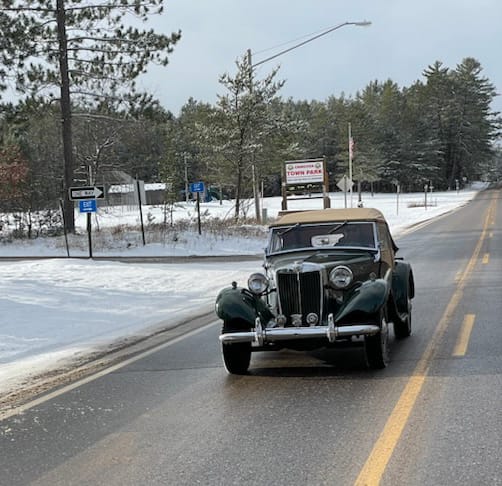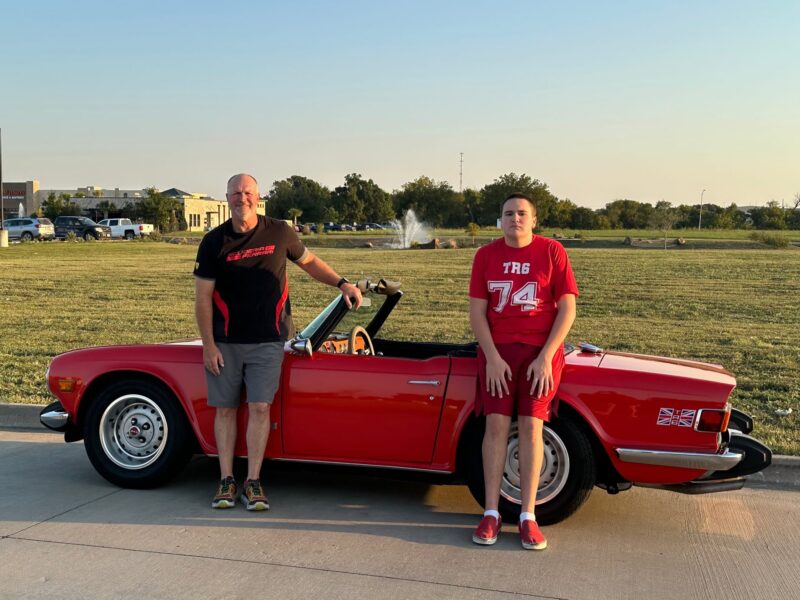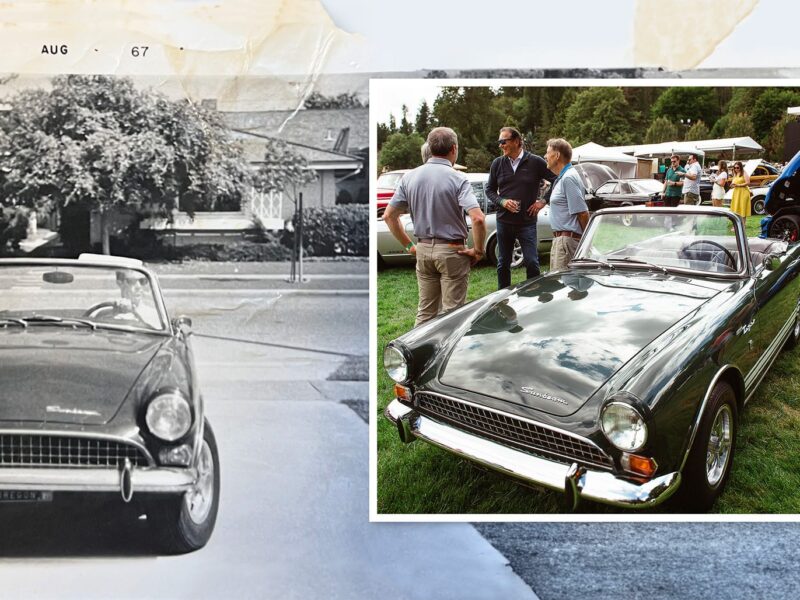by David Mathias
It’s mid-November and I live in Michigan’s Upper Peninsula. This morning I showed a friend a picture that was taken yesterday of me driving my 1952 MGTD down a country road in the snow. I was simply test driving it, but he asked if it was going to be my winter car. To this I responded, “My winter driver? I wish. Just try finding chains to fit those skinny tyres.” He expressed some concern over the car picking up some road salt. I don’t think there was much, if any salt on that particular road this early in the season and of course, I wiped it down pretty well and covered it before putting it away. No, that was my one and only ride—just to test it out.
I had been having problems with the car all summer and as anyone who has ever owned a British car will tell you, the cause of issues can be quite mysterious. Several weeks ago I was working on the car at the storage unit just a few yards from the local Laundromat. A fellow came out with a basket of laundry and noticed my car. He became very excited and came over, asking if he could look at it. “Well, of course,” I responded. Then as he drew closer I noticed he smelled like he had just crawled out of a bar. It was 12:30 in the afternoon, but then again this is the Upper Peninsula and so a certain amount of slack has to be given. He expressed great joy and told me of his love for vintage automobiles. I told him about the problems I had been having all summer and how I flushed the gas tank, replaced the fuel fitting, replaced the fuel filters and cleaned the carburetors. I told him how the car acted up whenever it would heat up… sputtering and choking out completely—especially when going around a turn. He suddenly became quite sober and said, “Don’t overlook the coil. When coils go bad on these old cars, they act just the way you described, and everyone tends to think it’s a fuel problem.”
“Okay my inebriated friend,” I thought to myself as I rolled my eyes, but then later gave the free advice some serious consideration and began searching everything I could find on the internet about faulty coils. Honestly, there’s not much information out there on faulty coils. If you do a Google search on ‘British sports car stalling out when going around a turn’ you will get quite a bit of information on the power steering belt for your 1980 Ford Granada. This whole internet thing might catch on when they can do a better job of reading our minds… and to some degree they have done a good job with algorithms, but they haven’t factored in the frequent abnormalities of our British automobiles.
Okay, the car would stall out terribly when going around a turn. Thus, why wouldn’t one think it was something sloshing around, making its way over to the filthy screen at the fitting located at the sludgy bottom of the 71-year.old tank? But a new coil is relatively inexpensive and so I ordered one. I removed the old coil and installed the new one which is no easy task as anyone who has done so on a TD will likely testify. I think my right arm and fingertips grew an extra inch or two from wrenching on the bolts located on the bulkhead while simultaneously reaching around to the nuts and washers that are just above the pedals inside the car. I felt great pride in getting the new coil installed with dropping a lock washer or nut only a dozen times in the process and surprisingly not filling up the swear jar.

The car fired up and ran smoothly, but the big test lies ahead in test driving it the same 20-mile trip with its hills and curves that had been giving the car such a problem the last three times this summer.
I was quite pleased. The car ran exceptionally well and gave absolutely no signs of sputtering or stalling out. It was a true champion. And as it turns out, this morning my local Jeep mechanic said the inner core of the faulty coil could in fact, move side-to.side when going around a turn and really screw up the polarity of the magnet resulting in …something … something. I zoned out right after I was satisfied that I heard what I needed.
On reflection, it was really quite serendipitous running into that daytime drunk with the advice about the coil. I wish I could track him down and buy him a pitcher of beer… maybe a bottle of cough syrup. Ah, but we’ve all moved on from those days.
So, today I find myself harkening back to the winter of 1978 driving in a British sports car. I can just imagine this as a story for the grandkids. The words “Gather around kiddies” would be followed by groans and heavy sighs.
My ’65 Triumph had nothing but a quarter-inch piece of plywood for the driver’s side window and believe me, driving that winter was a challenge. Seriously, you know those Brits had no idea of what a heater and defroster were supposed to do.
My car’s nickname was “Mevy.” I saw an ad in the Wausau Herald for a “1965 Triumph Mevy 350” for sale by Lake Dubay near Steven’s Point. This old guy was a real hack. It was a TR4 and one of the front hood hinges had rusted away and so he put a pair of cabinet hinges on the back of the hood (by the wipers) and had hood pins holding it down. He had a cut-off broomstick to hold the hood open. He probably used the sweeping.end of the broom on another project. It was $500 and so I forked over the money. Before leaving I asked, “So, what’s a Mevy 350?” I’ll never forget the expression on the old guy’s face as he looked at me squinting one eye. He replied, “I don’t know… what is a Mevy 350?” So, obviously it was a mistake in the newspaper. I actually made it all the way back to Wausau before the brakes gave out and I nearly clipped some guy on a bike. It was only after this that I learned of the expression, Caveat Emptor.
I still have a small piece of the broomstick. A memento for the sentimental old fool I am. I suppose I’ll be cremated with it, and a few key fobs, hood emblems, and shift knobs.
The following spring I found a hood hinge at Don Bennet’s Sports Cars in Hortonville, Wisconsin—a junkyard that specialized in foreign cars. Wow, that place was a trip. Forty acres of Mercedes sedans, Porsches, Peugeots, Mayflowers, Fiats, Alfa Romeos, Magnettes, MGAs, Heralds, TR3s—any old foreign car you could think of. They’d all be worth countless bucks now—priceless vintage tin. I returned there in the early ’80s to buy a BMW 530i—trading off a Volvo wagon. There wasn’t a single European car in the place—all Japanese. I remember considering at the time that maybe I wasn’t doing a very good job of changing with the times… nah. Well, I did a valve job on Mevy and the investment at that time was the cost of a set of gaskets, since my brother had a valve grinder in his shop. After driving Mevy for a year or two, I sold it and went back to restoring my ’66 TR4A.
The Fox Valley of Wisconsin has always been a hotbed for sports cars—maybe because of its proximity to Road America in Elkhart Lake? I don’t know, but every region of this great patchwork we call the United States of America seems to have its unique attributes and peculiarities. Napa Valley for wine, Los Angeles for movies and pretentious actors, New York for its Wall Street wizards, Wisconsin for cheese, beer, beer and more beer, Florida for alligators, hurricanes and other methods of untimely and horrific death, Kentucky for horse racing and Iron River, Michigan, for its locals driving their ATVs down the street past my house full throttle at 3am to get in line for the dispensary when it opens at eight.
I’ve already spent any inheritance that might have been there for my children, their children, and their children’s children on my British car habit. I will sell plasma again this week to help offset the overwhelming costs. I’m down to 97 pounds and dare not venture out in a strong wind. Maybe I could start a ‘go fund me’ page. People will read: “British Car Owner” and immediately get all emotional, shed a tear, and pull out their wallets.
They say that misery loves company. Personally, there doesn’t need to be two of us sitting on the side of the road and so that expression makes absolutely no sense whatsoever.
Well, things could be worse and things will get better—now those are two catch phrases for the hopeless, the naïve and your typical Brit car enthusiast!








'Winter Driving In Brit Cars' has no comments
Be the first to comment this post!